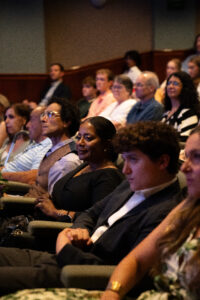The origin of the phrase “Speak Truth to Power” has been attributed to a number of people and organizations. Most people recognize the American Society of Friends (ASF – Quakers) and one particular Quaker, Bayard Rustin, as the original source. In 1942, Rustin, a Black Quaker and the principal organizer of the March on Washington, wrote that “the primary social function of the religious society of friends is to ‘speak the truth to power”. In 1955, ASF published Speak Truth to Power: A Quaker Search for an Alternative to Violence.
In 2001, Kerry Kennedy, president of RFK Human Rights, embraced the phrase in writing of her book Speak Truth to Power. In her book, she focused on uplifting human rights defenders from around the world who were doing just that, speaking their truth, often at great personal risk. She moved important narratives of people speaking truth to power at the local and national level to the international arena. In so doing, she played an important role in transforming the global narrative and helping bring about a greater understanding of human rights in both theory and practice.
The narratives that Kerry celebrated and put out into the world are ones of people who believed that the world could be a better, kinder, freer, and more just place for everyone. The human rights education work that emerged from the stories she shared, and the many new ones since, provides learning opportunities that elevate multiple perspectives. Specifically, the work brings the narratives of the oppressed and vulnerable into our collective story as opposed to blindly accepting the dominant narrative, the narratives put forth by the ones in power.
Today we find ourselves in a time when specific narratives are being removed from our collective history, erased from libraries and curricula. Educators are being told what to teach and how to teach it. Now more than ever, we need to ensure that our collective national narrative is truly reflective of who we are – the good, the bad, the resilient, the courageous, the defender of human rights and social justice.
How do we do this? First, we listen to the educators. Second, we work with educators to both create or modify resources that can safely be mapped into their lesson plans and/or programming and, we provide professional development. Third, we listen to students and support the work they want to do in defending and promoting human rights with programming like the STTP video contest. We do all this work with and in partnership with those on the front line. We bring the narratives that resonate with the local communities, we uplift the stories from communities that are being silenced and we learn from them, we find common connections with the work of those who have come before us and most importantly, we speak truth to power.


